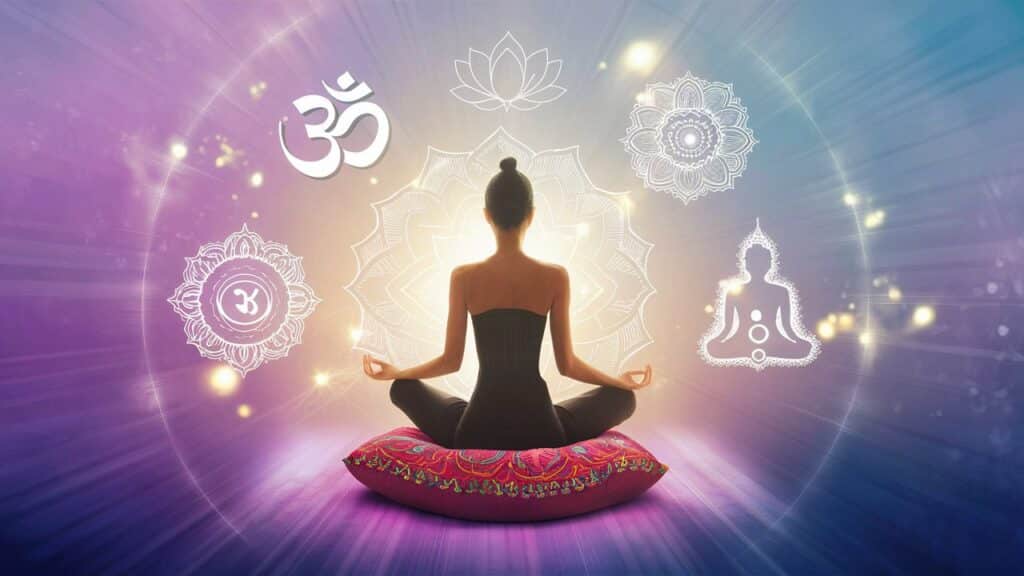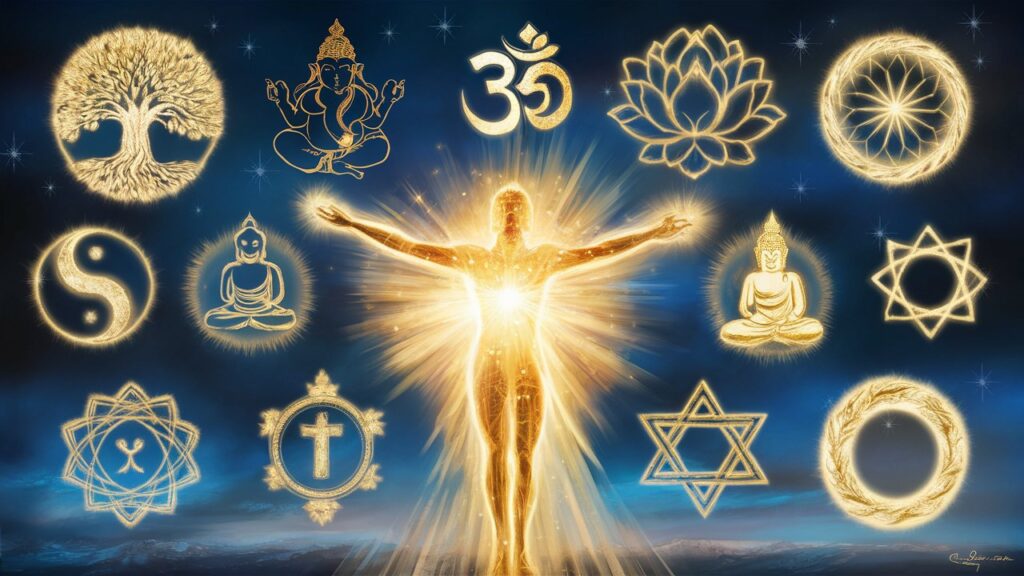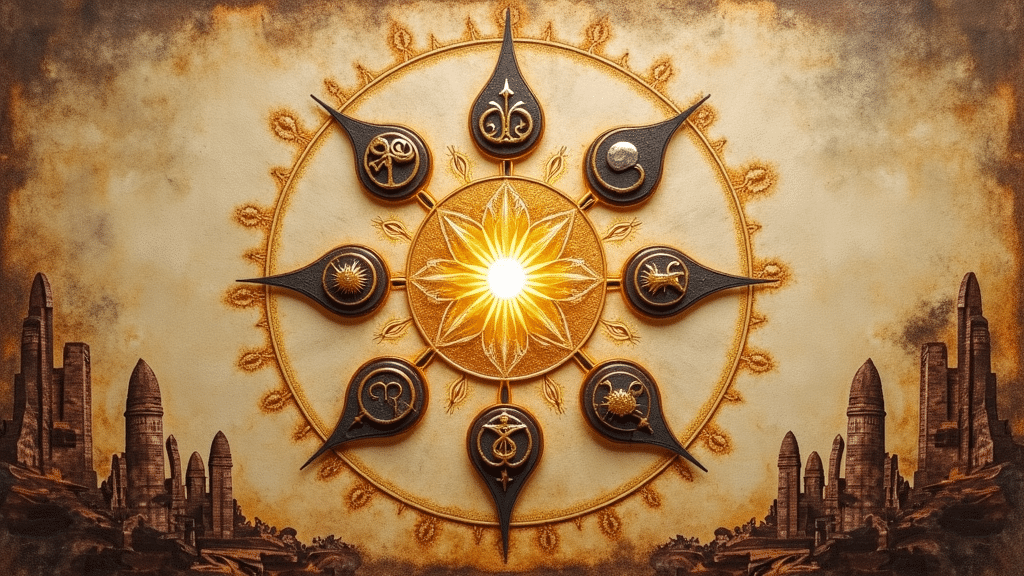Discover the power of symbols in meditation and how they can elevate your practice to new heights. Symbols have long been used as tools for spiritual growth and self-discovery, offering deeper meaning and inspiration for those seeking mindfulness and enlightenment.
When it comes to meditation, incorporating symbols into your practice can help you connect with your inner self, balance your chakras, and reach higher states of consciousness. From ancient practices to modern interpretations, there are various symbols that hold spiritual significance and can enhance your meditation experience.
Immerse yourself in the world of meditation symbols and unlock their transformative power. Explore the symbolism behind Namaste, OM, Chakra Signs, Mandala, Meditating Buddha, and Lotus Flower. Each symbol carries unique qualities and can guide you on your spiritual journey.
Key Takeaways:
- Discover the power of symbols in meditation and how they can enhance your practice
- Explore the symbolism behind Namaste, OM, Chakra Signs, Mandala, Meditating Buddha, and Lotus Flower
- Learn how symbols can deepen your connection to yourself and the divine
- Understand the significance of chakras and how they contribute to inner harmony
- Experience profound growth and transformation through the use of meditation symbols
The Significance of Yoga Symbols in Deepening Your Practice


Yoga symbols hold deep spiritual significance and can greatly enhance the yoga and meditation practice. They serve as visual representations of profound concepts and can help practitioners deepen their connection to themselves and the divine. Understanding the spiritual significance of these symbols can unlock new levels of awareness and mindfulness, allowing for a more profound and transformative practice.
The Power of Aum
Aum is a sacred sound and symbol in yoga, representing the universal vibration and the interconnectedness of all beings. Chanting Aum during yoga practice can help unify the mind, body, and spirit, promoting a state of deep relaxation and inner harmony.
The Elegance of the Lotus Flower
The lotus flower is a symbol of purity, enlightenment, and the ability to rise above challenges. Its beautiful form and serene presence remind practitioners to embrace growth, transformation, and the pursuit of higher consciousness.
The Protection of the Hamsa
The hamsa symbol is believed to provide protection against negative energy. Its hand-shaped design serves as a talisman, warding off evil and inviting positivity and good fortune into the practitioner’s life. Incorporating the hamsa into yoga practice can create a sense of safety and security.
The Sacredness of the Mandala
Mandalas are intricate geometric designs that represent the unity and harmony of the mind, body, and soul. Meditating on or visualizing mandalas during yoga practice can aid in concentration, promote inner peace, and facilitate a deeper connection to the spiritual realm.
The Wisdom of the Buddha
The image of Buddha symbolizes enlightenment, compassion, and inner peace. By incorporating the image of Buddha into yoga practice, practitioners can tap into these qualities within themselves and cultivate a deeper understanding of their own spiritual journey.
The Energy of the Chakras
The chakras are energy centers in the body that influence our physical, mental, and emotional well-being. Understanding and working with the chakras during yoga practice can help balance and harmonize these energy centers, bringing about a greater sense of overall health and vitality.
By incorporating these powerful symbols into yoga practice, practitioners can deepen their connection to the spiritual aspects of the practice and experience profound growth and transformation. Whether through chanting Aum, meditating on the lotus flower, or visualizing the energy centers of the chakras, these symbols serve as gateways to higher states of consciousness and enlightenment.
Read More About Understanding Spiritual Symbols and Their Significance
Exploring Common Yoga Symbols and Their Spiritual Significance


Yoga symbols have a deep spiritual significance that can enhance the practitioner’s connection to the practice. They serve as visual representations of profound concepts and can inspire and guide individuals on their spiritual journey. Understanding the symbolism behind common yoga symbols like Aum, the lotus flower, the hamsa, mandalas, Buddha, and chakras can deepen one’s understanding and experience of yoga.
Aum: The Sound of the Universe
Aum, also known as Om, is a powerful symbol in yoga and Hinduism. It represents the primordial sound that created the universe. Chanting Aum can unify the mind, body, and spirit, helping practitioners connect with the divine and attain a sense of peace and balance within.
Lotus Flower: Purity and Enlightenment
The lotus flower symbolizes purity, enlightenment, and the ability to rise above challenges. Like the lotus, which grows in muddy waters but remains untainted, the practitioner can cultivate purity and transcend the difficulties of life through the practice of yoga.
Hamsa: Protection and Spiritual Luck
The hamsa symbol, often depicted as a hand with an eye in the center, represents protection against negative energy and brings spiritual luck. It is believed to ward off evil and bring blessings to the practitioner, fostering a sense of safety and divine guidance.
Mandalas: Unity and Harmony
Mandalas are intricate geometric designs that symbolize unity and harmony. They can be used as focal points during meditation, aiding in concentration and facilitating a deeper sense of connection with oneself and the universe.
Buddha: Enlightenment and Inner Peace
The image of Buddha represents enlightenment and inner peace. Buddha serves as an inspiration for practitioners on the path to self-discovery, compassion, and empathy. The symbol reminds us to cultivate these qualities within ourselves.
Chakras: Energy Centers
Chakras are energy centers located along the spine, each corresponding to different aspects of physical, emotional, and spiritual well-being. Understanding and balancing the chakras through yoga can help individuals achieve inner harmony and vibrant health.
By exploring and incorporating these common yoga symbols into the practice, practitioners can deepen their connection to themselves, the divine, and the transformative power of yoga. Each symbol holds profound spiritual significance and can act as a guide, inspiring personal growth, and illuminating the path to self-realization.
| Symbol | Spiritual Significance |
|---|---|
| Aum | Represents the sound of the universe and unification of mind, body, and spirit. |
| Lotus Flower | Symbolizes purity, enlightenment, and the ability to rise above challenges. |
| Hamsa | Brings protection against negative energy and spiritual luck. |
| Mandalas | Represent unity and harmony, aiding in concentration and meditation. |
| Buddha | Represents enlightenment and serves as an inspiration for compassion and empathy. |
| Chakras | Are energy centers that play a vital role in achieving inner harmony and well-being. |
Read More About Exploring Common Yoga Symbols and Their Spiritual Significance
Conclusion
Symbols in meditation hold great significance and can greatly enhance your practice, deepening your connection to yourself and the spiritual realm. By incorporating these powerful symbols into your meditation routine, you can unlock a profound sense of mindfulness, enlightenment, and inner harmony.
Throughout this article, we have explored various symbols such as Aum, the lotus flower, the hamsa, mandalas, and the image of Buddha, all of which have their own unique spiritual significance. Understanding and utilizing these symbols can guide you on a transformative journey of self-discovery and self-awareness.
As you integrate these symbols into your practice, they act as visual representations of spiritual concepts, creating a sacred space and fostering a deeper connection with the divine. They inspire and guide you towards a deeper understanding of yourself, unlocking the potential for profound growth and transformation.
So, take a moment to reflect on the power of symbolism in meditation. Embrace these ancient symbols and let them infuse your practice with purpose, meaning, and inspiration. Allow their spiritual significance to enhance your journey and open the door to a deeper connection with yourself and the higher realms of consciousness.
FAQ
What is the significance of meditation symbols?
Meditation symbols hold specific meanings and can be powerful tools in enhancing the meditation practice. They can help elevate mindfulness, reach higher states of consciousness, and balance chakras. Incorporating these symbols can bring deeper meaning and inspiration to enhance spiritual development.
What are some essential meditation symbols?
Some essential meditation symbols include Namaste, OM, Chakra Signs, Mandala, Meditating Buddha, and Lotus Flower. Namaste is a greeting used to honor and express gratitude during meditation. OM symbolizes the universe and can be chanted to connect the mind and spirit. Chakra signs represent different aspects of well-being. Mandalas symbolize the spiritual journey. Meditating Buddha represents compassion and empathy. Lotus flower symbolizes purity, rebirth, and self-regeneration.
How do yoga symbols enhance the practice?
Yoga symbols hold deep spiritual significance and can enhance the yoga and meditation practice. Aum, known as the sound of the universe, can unify the mind, body, and spirit. The lotus flower represents purity, enlightenment, and new beginnings. The hamsa symbol provides protection and luck against negative energy. Mandalas symbolize unity and harmony. The image of Buddha represents enlightenment and peace. Chakras play a crucial role in achieving inner harmony. Namaste fosters a deeper connection to the practice.
What does Aum symbolize in yoga?
Aum represents the sound of the universe and unifies the mind, body, and spirit. Chanting Aum can help practitioners connect with their inner selves and experience a sense of oneness.
What does the lotus flower symbolize in yoga?
The lotus flower symbolizes purity, enlightenment, and the ability to rise above challenges and transform oneself. It represents the journey towards spiritual awakening and self-realization.
What is the significance of the hamsa symbol in yoga?
The hamsa symbolizes protection and can ward off negative energy. It is believed to bring good luck, happiness, and prosperity to those who embrace its symbolism.
What do mandalas symbolize in yoga?
Mandalas represent unity and harmony of the mind, body, and soul. Their intricate designs aid in concentration and meditation, helping to achieve a state of inner peace and balance.
What does the image of Buddha represent in yoga?
The image of Buddha represents enlightenment and the potential to transcend suffering. It serves as a reminder to cultivate compassion, empathy, and inner peace on the path to spiritual growth.
How do chakras impact the yoga practice?
Chakras are energy centers in the body that play a vital role in maintaining balance and well-being. Each chakra corresponds to different aspects of our physical, emotional, and spiritual health. Understanding and balancing the chakras can enhance the yoga practice and promote overall wellness.







